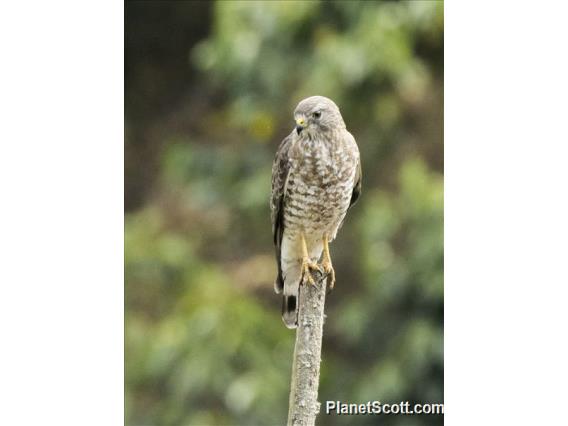Broad-winged Hawk (Buteo platypterus)






About Broad-winged Hawk (Buteo platypterus)
- Kingdom: Animals
- Phylum: Chordates
- Class: Birds
- Order: Hawks, Eagles, Kites, and Allies
- Family: Hawks, Eagles, and Kites
The broad-winged hawk is a medium-sized hawk of the genus Buteo. During the summer, some subspecies are distributed over eastern North America, as far west as British Columbia and Texas; they then migrate south to winter in the Neotropics from Mexico south to southern Brazil. Other subspecies are all-year residents on Caribbean islands. As in most raptors, females are slightly larger than males. Broad-winged hawks' wings are relatively short and broad with a tapered, somewhat pointed appearance. The two types of coloration are a dark morph with fewer white areas and a light morph that is more pale overall. Although the broad-winged hawk's numbers are relatively stable, populations are declining in some parts of its breeding range because of forest fragmentation.
Source: Wikipedia
Trips
Visits
-
-
2006-12-17
Mindo - Bellavista, Ecuador -
2007-10-10
Cardel, Mexico -
2009-01-26
Mountain Pine Ridge, Belize -
2009-02-18
Parque National Palo Verde, Costa Rica -
2009-02-25
Corcovado National Park - La Sirena, Costa Rica -
-
2009-03-15
Boca de Cupe, Panama -
2009-03-19
Punta Patino, Panama -
2012-07-09
Sax-Zim Bog, United States of America -
2013-04-14
Austin, United States of America -
2013-04-19
Bolivar Peninsula, United States of America -
-
-
-
-
-
-
2023-02-13
Verada Rio Claro, Colombia -
2023-09-30
La Selva, Costa Rica -
-
-
-
-
-
-
-
-
-
-
-
-
-
-
-
-











